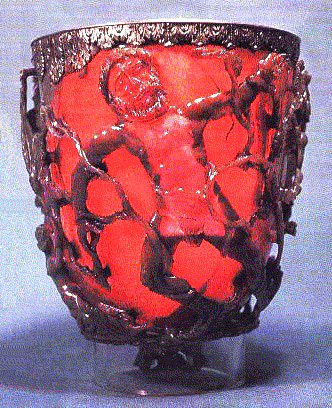The Lycurgus Glass
Those who attended the recent meeting of the British Scientific Society were presented with an ancient mystery - the Lycurgos Cup. This is an ancient piece of glassware that has the curious property of appearing ruby red when light shines through it, but pea green when the light shines upon it.

| |
| When seen by transmitted light, the glass in this cup appears ruby red. |
There is no doubt that the ancient world knew and valued glass, though they did not make large objects, like bowls and vases, out of it. Possibly they lacked the technique of gradual cooling which prevents the glass self-destructing as it cools. Exquisite little phials and vases of clear glass, or made of bright swirls of coloured glass, adorn many a museum shelf. Even more intriguing are the slightly greenish coloured glass objects, many with an irridescent patina which it is impossible to produce today.
Unfortunately the patina is not the work of ancient craftsmen exercising some long-lost mystery. If you wish to produce similar beauty, go down to your local shop and buy a set of ordinary clear glasses. Bring them home and bury them in your back yard, then leave them there for approximately 2,000 years. At the end of that time dig them up and invite your neighbours round to admire your unique irridescent glasses!
The one thing that the ancients never used glass for was for windows. Until relatively recently the only way to work glass was by dipping a hollow tube into a vat of molten glass. The craftsman then spun the tube so that the blob of molten glass expanded sideways under centrifugal force. Judging the work carefully, the craftsman then blew down the tube, inflating the blob of molten glass like a balloon. When he had achieved the right shape, the craftsman used a pair of shears to cut the blob - now a vase or whatever - off the tube.
The only way to produce flat glass was to spin the tube faster, producing a flat disk with the characteristic bulge in the middle where it had been attached to the tube. This is the origin of the "bull's eye" glass so beloved of Olde Worlde Tea Shoppe owners with an eye to the tourist trade. Naturally the shape distorted anything viewed through it, which led to the principle that no one could bear witness to anything seen through glass, a principle that was only abolished when a sea-captain, having witnessed a murder on a nearby ship through his telescope, was prevented from testifying by the fact that he had seen the deed "through glass"!
These days huge sheets of flat glass are produced by means of a float, a boat-shaped metal object with a carefully machined slot in the bottom. The float is dropped into a vat of molten glass and, naturally, begins to sink as the glass flows in through the slot in the bottom. Giant tongs grip the sheet of glass that extrudes (or should that be "intrudes") through the slot and lift it up and out of the float, thus keeping the float afloat and producing a sheet of glass as long as you wish.

| |
| The block in the middle of the room is an abandoned vat of once-molten glass in a tomb at Beth Shearim. |
Modern techniques of glass-making have produced some wonderful materials: safety-glass, a sandwich of glass and plastic; bullet-proof glass; toughened glass with those stripey patterns seen in the windscreens of oncoming cars; and, of course, crystal, glass with a small amount of lead mixed in. In this latter case, of couse, the lead is melted and atoms of the metal join with the atoms of silicon etc and are incorporated into the crystalline structure of the glass as the substance cools.
It seems, however, that the makers of the Lycurgos Glass were even smarter. Analysis of the material of which it is made reveals that the glowing and contradictory colours are due to the fact that tiny flakes of gold and silver have been incorporated into the glass. As both these metals have melting points similar to that of lead - which is well below the melting point of glass - the mystery is how the ancient craftsmen were able to mix in the miniscule flakes of precious metal without them melting.





